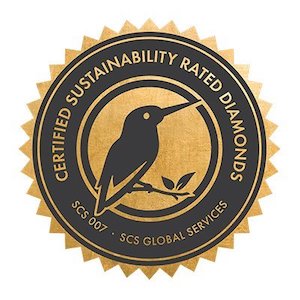
SCS Global Services, the company behind the Certified Sustainability Rated service for diamonds, now hopes to develop a similar program for colored gemstones.
Rating gemstones on sustainability could be tricky, admits Katherine Weymouth, director of SCS’ jewelry program, given that the industry is mostly composed of artisanal suppliers.
“There is still a large amount of research and exploration that will need to be conducted before a trial use standard could be developed,” she says. “We would like to pursue that research and exploration this year to have a better understanding of what is realistic and practical.”
Diamond rating “is part of a larger initiative we have within the company to bring sustainability rating services to the larger jewelry sector,” SCS cofounder and senior vice president Linda Brown tells JCK. “It’s always been part of our vision. Right from the get-go, we positioned the Sustainability Rated Diamond as part of a larger standard.”
SCS will begin looking at other jewelry materials once it releases its final diamond sustainability rating criteria next month.
Some of the company’s lab-grown clients have been griping about the cost of the certification, particularly in the face of declining lab-grown diamond prices. Brown indicated that the price will be adjusted—meaning lowered—once the standards are finalized.
So far, all the companies getting certifications are diamond growers, which—along with some language on the SCS site—has led some to think that SCS views synthetic stones as more eco-friendly than mined gems.
Brown says that’s not the case: “It’s not our position that one process [growing or mining] is more sustainable than the other. We are agnostic as far as technology. We’re not interested in pitting mined diamonds against lab-grown diamonds. That’s a fool’s errand. There’s no product that doesn’t have an impact.
“The lab sector has its unique challenges as well as its differences,” she continues. “There are differences among the miners and the lab-grown producers that have to do with where and how they operate.… We are interested in moving people in these sectors to the highest possible performance.”
SCS has also faced complaints about its clients making claims that perhaps are not backed up by the certifications. For example, “Certified Sustainability Rated” is not the same as “certified sustainable,” though that was the original wording. (We should note that the label sustainable has no universally agreed-on criteria, and some want the term banned.)
“We give [our clients] guidelines on how they’re supposed to talk about the certification claims,” says Weymouth. “But are we going to catch 100% of every [misrepresented] claim? Probably not.”
Certain industry players have called for more transparency in the now-5-year-old program, noting the certification doesn’t provide any data on a diamond grower’s energy use or environmental impact—which it was originally supposed to.
“That is the producers’ responsibility to put out,” Weymouth says. “We ultimately cannot share their information in terms of their energy usage, consumption, and offsets.”
Stanley Mathuram, who was the public face of SCS’ diamond initiative as its executive vice president, left the company in November.
(Photo courtesy of SCS Global Services)
- Subscribe to the JCK News Daily
- Subscribe to the JCK Special Report
- Follow JCK on Instagram: @jckmagazine
- Follow JCK on X: @jckmagazine
- Follow JCK on Facebook: @jckmagazine






